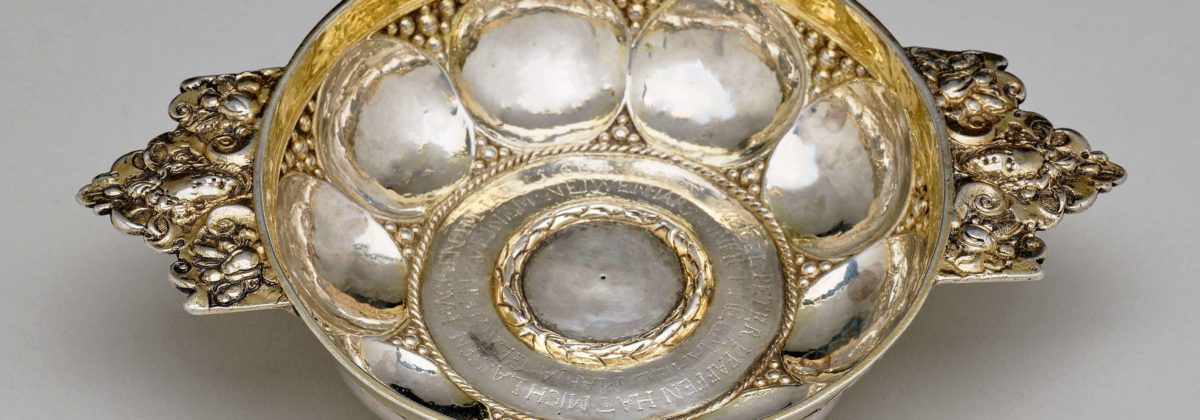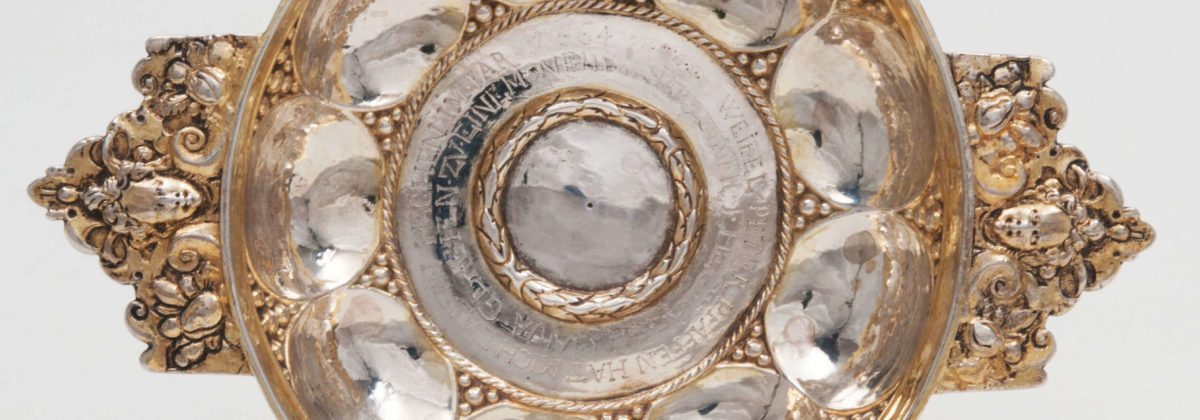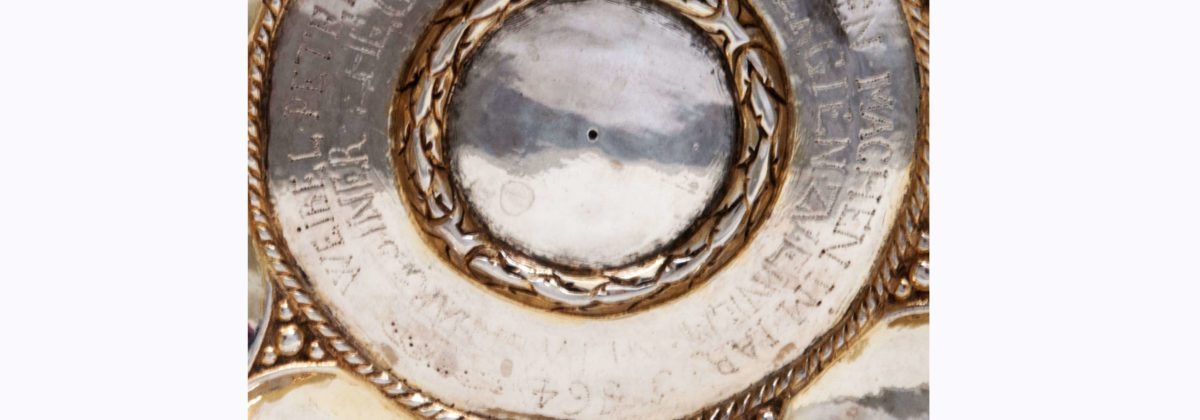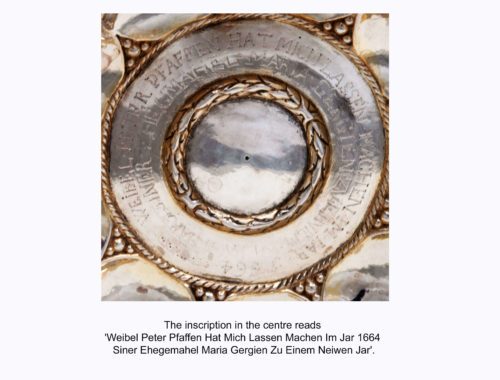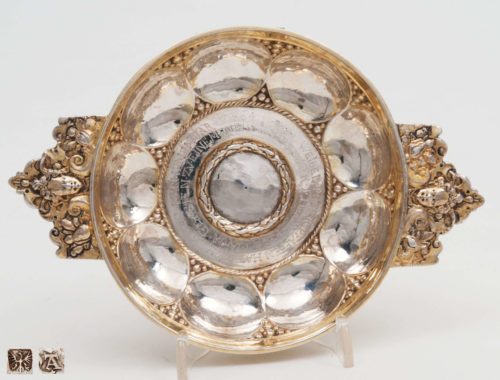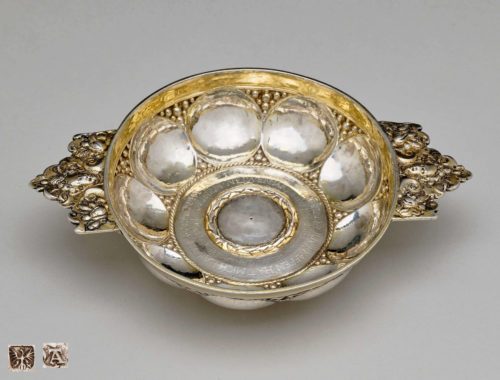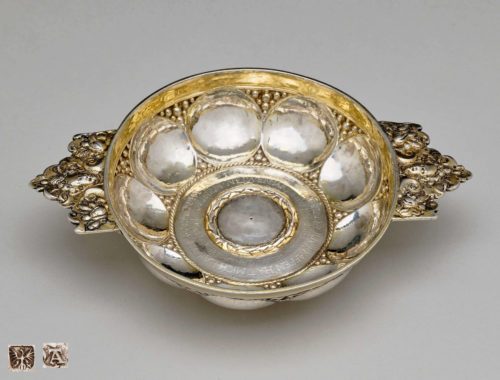Object number 385
Brig, dated 1664
Anton Tuffitscher
City’s hallmark: an eagle for Brig (so as on the coat of arms of the city) (s. Ruppen, t. I, p. 430, no. 11 and Ackermann-Kuonen et al., 2015, t. II, no. 3).
Maker’s mark: “AT” ligated into another for Anton Tuffitscher (s. Ruppen, t. I, p. 430, no. 11 und Ackermann-Kuonen et al., 2015, t. II, no. 3).
Length: 18 cm (with the handles) (7,08 in.); weight: 171 gr. (5 oz. 9dwt.)
Detailed Description
Drinking Bowl with Two Handles, Silver Gilt
The round drinking bowl, silver-gilt, stands on a low foot and has two handles on the sides, chased with fruits and a putto head in the middle. Inside the bowl’s body is formed through nine round arches, which have smaller bulges in between, similar to a pearl decor. In the middle of the bottom the decoration consists of a twisted ring and further inwards a raised, central wreath of corn. Between ring and wreath the following engraved inscription: “Weibel Pfaffen Hat Mich Lassen Machen in Jar 1664 Siner Ehegemahel Maria Gergien Zu Einem Neiwen Jar. The marks ligated on the exterior side of the bottom. The bowl is partly gilt.
This drinking bowl presents a widespread type in Switzerland: arched bottom with circular embossed moulds. This form probably dates back to 15thcentury and follows models from Burgundy or the Netherlands. Such drinking vessels became known in Switzerland as spoils during the wars of 1476/77 against the Burgundian duke Charles the Bold (1433-77).
Historical and cultural considerations on Brig (Switzerland/Canton of Valais) and Provenance Information of the Drinking Bowl
In Brig (canton of Wallis/Valais), the production of silver objects is documented since the seventeenth century (Lanz 2004: 21).
Peter Pfaffen is documented in the Valais area by a panel with his coat of arms in the Finnubielhaus in the village Finnen of the municipality Eggerberg (district Brig), which bears the following inscription: “Hr Peter Pfaffen Hauptmann des/ersten auf-Zug [des] L[öblichen] Zenden Brÿg ietziger/Meier des Frigericht an Finden 1687” (History Museum Sitten, s. Ackermann-Kunonen, et al., 2015: 50/51, fig. 65). “Zenden” or “Zehnden” (Fr.: dizain) was the name for the districts in the former Republic of Valais.
The death of Peter and Maria Pfaffen was documented in the book kept by Kaspar Stockalper (1609-1691).
Kaspar Stockalper was the son of Peter II Stockalper and was a prominent personality for Brig and Valais – almost for the entire 17th century. Peter Pfaffen is possibly related to him in a professional or official way. Besides, Kaspar Stockalper has shaped different sides of the political, cultural and economic life of Brig.
Kaspar Stockalper studied as a notary and became involved with public services in Brig in a young age. In 1633 he undertook a trade and study trip to Burgundy, France, Belgium and the Netherlands. In 1634 he succeeded in leading the Princess Marie-Marguerite de Bourbon-Soisson – wife of the Prince of Savoy – across the Simplon with an entourage of four princes and 50 nobles. This earned him a considerable fortune as well as good contacts to other princely courts in Europe. As a result of his achievements, he was granted the postal privilege from Milan to Brussels by the court of Milan. A few years later he took over the run-down iron mine in Grund from the Brig citizens. After 1640 he also got involved into politics. He became treasurer and then financier of the citizens of Brig and afterwards he served almost all offices of the district Brig. Later, he was also active in political and diplomatic missions in France. Parallel to these offices, Stockalper was engaged in mining, soldier service, transit and thus acquired several monopolies, including the most important: salt monopoly. In 1653, Emperor Ferdinand III elevated him to the rank of imperial knight, while other princes honoured him in a similar way. Between 1658 and 1678, he built the largest baroque private palace in his time in Switzerland. 1679-1685 he had fled to Milan. In 1691, Kaspar Stockalper died in Brig.
Maker
During the second half of the 17th century Anton Tuffitscher created various liturgical devices. These are mainly located in Brig (Kollegiums- und Klosterkirche) but also in other places in the district of Brig (e.g. in Termen and in the parish church of Münster, Goms).
Literatur
Lanz, Hanspeter und Schweizerisches Landesmuseum Zürich/Badisches Landesmuseum Karlsruhe (Hrsg.), Silberschatz der Schweiz: Gold- und Silberschmiedekunst aus dem Schweizerischen Landesmuseum, Karlsruhe: Info-Verlag, 2004.
Ackermann-Kuonen, Carmela, et al./Gesellschaft für Schweizerische Kunstgeschichte (Hrsg.), Die Kunstdenkmäler des Kantons Wallis: Der Bezirk Brig, Bd. 4, Basel: Gesellschaft für Schweizerische Kunstgeschichte, 2015.
Garbely, Leo, ‚Die Pfarrkirche von Münster (Goms)‘, 47-74 In: Vallesia, Bd. IV, 1949.
Ruppen, Walter, Die Kunstdenkmäler des Kantons Wallis, Bd. 1: Das Obergoms, die ehemalige Großpfarrei Münster, Birkhäuser Verlag: Basel, 1976.
Imboden, Gabriel/Schweizerische Stiftung für das Stockalperschloss/Stadtgemeinde Brig-Gils (Hrsg.), Das Stockalperschloss in Brig, Bern: Gesellschaft für Schweizerisch Kunstgeschichte, 2005.


